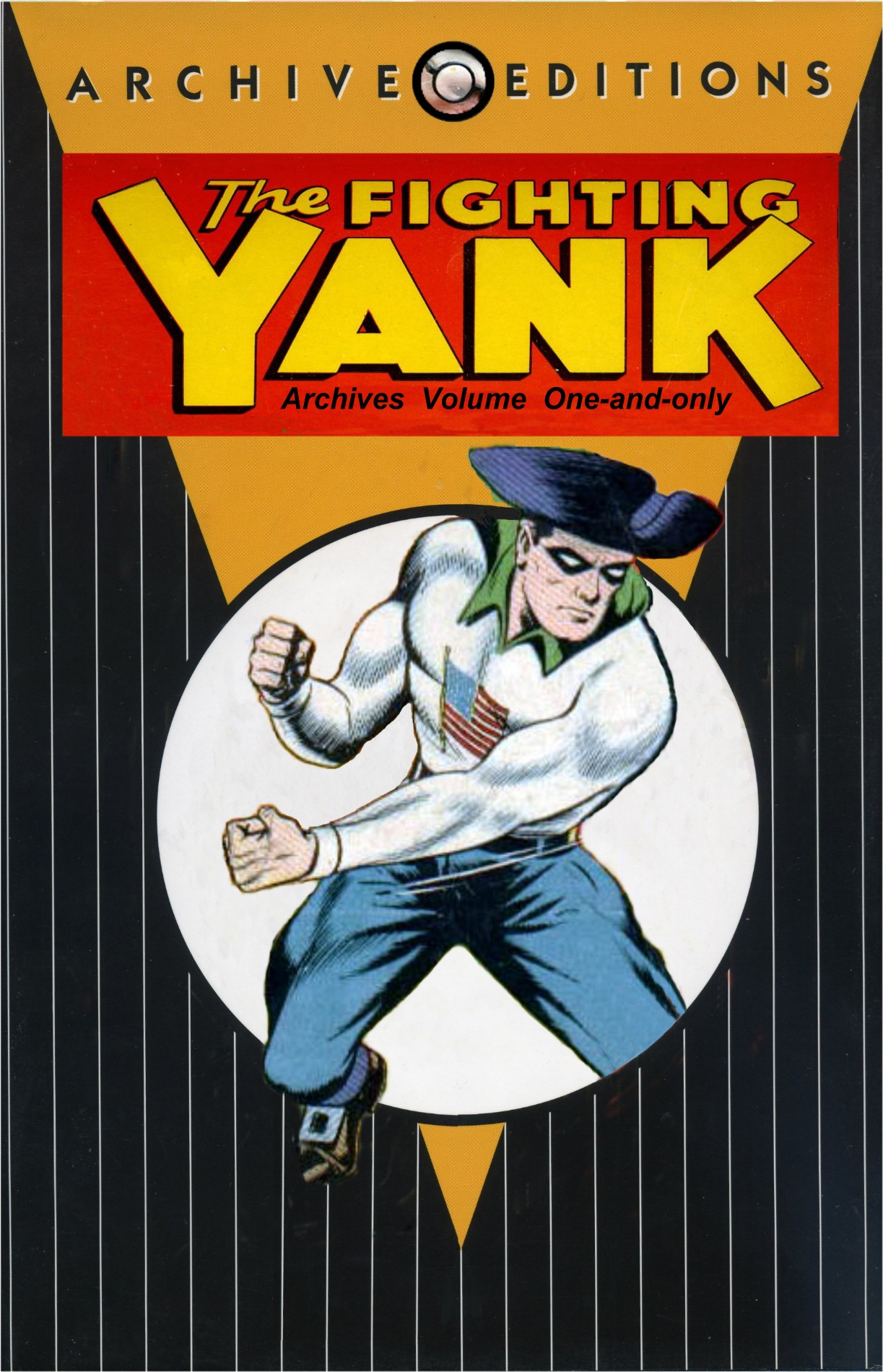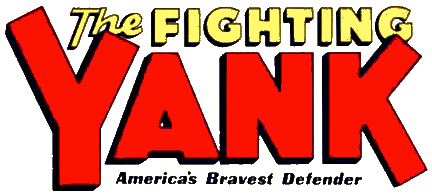Introduction:
The year is 1939. Comics are still trying to duplicate the successes of Superman and Batman. But, not too closely as Fox demonstrated with Wonder Man prompting swift legal action from National. Europe is in chaos and a World War is starting, though through its isolationist tendancies, America will stay out of it for almost 2 years. This would be the gestalt of a new hero: one that was super-strong, bulletproof, but would immediately recognized as a symbol of America.
The Shield by MLJ, with a cover date of January, 1940, would be comics' first patriotic-themed hero, beating the most famous, Captain America, by just over a year.He'd be followed by a host of others, Quality would bring out Uncle Sam himself and Stormy Foster, the Great Defender and Miss America. Fox would manage to debut the Eagle before the good Captain. Timely would give us Captain America, the Defender (possibly Captain America redrawn), Centaur would answer with Man of War. MLJ would come back with Captain Flag. Standard/Nedor/Better would give us the American Crusader, Liberator, and of course, the Fighting Yank. Captain America would spawn a legion of Captains: Captain Battle, Captain Battle, Jr., Captain Courageous, Captain Fearless, Captain Freedom, Captain Victory from various companies with names like Harvey, Hillman, Holyoke.
The patriotic heroes were by default political heroes in a way that the others weren't. From the start, the Shield was secretly an FBI man and was involved in international intrigue, plots of sabotage and invasions while Steel Sterling and the Comet fought mad scientists. Captain America was seen punching Hitler in the face, Captain Flag's origin and most of his adventures pitted him against a Nazi agent. But, there are politics that lace all the early comic and pulp heroes stories, from the Communist takeover of Russia to the Japanese invasion of China, these served as inspirations and plots of stories.
And what is interesting, the vast majority of the American Patriotic heroes came BEFORE Pearl Harbor. There were a few notables that came later such as Timely's own Miss America, but for the most part the best of them were already here. One might argue it was because once we were involved in the War, the companies decided that people wanted escapism, not to be reminded of the war. That was National's policy and it¹s why there are so few Superman, Batman and JSA stories that dealt with the War. It is notable that National actually lacked any major overtly patriotic hero, the Star Spangled Kid and Stripesy possibly being the most well-known. However, that was obviously not the case elsewhere as every other company had their heroes as deeply involved as before if not moreso. Fawcett's villainous Captain Nazi (and later Captain Nippon) were not foes of the war-influenced Minute Man or Spy Smasher but of Captain Marvel, Jr. Characters with the War as the backdrop to their characters appeared: Airboy, Blackhawk, Black Angel, Citizen V, the Sniper, Espionage X, the Boy Commandos, etc. Superman may not have been fighting the Germans or Japanese, but everyone else was.
The War was good for the superheroes. Even if no new ones appeared, they did all right. But, then the War ended and the various heroes faded away, especially the ones who were dependent on the War for their livelihood. And the heroes had gone mainstream, it was hard to be too political afterwards. Where they grew out of unrest in Europe, the gangster mythology and corruption of the Depression, post-War it was hard to slip back into straightforward adventure stories with no easy villains to go after.
Which gives us the proper context of the Fighting Yank. Wish I could say he debuted before Captain America, but he didn't though he was part of the pre-Pearl Harbor crew. What he really had going for him was that the majority of the covers depicting him were most often done by Alex Schomburg. At least that was my initial attraction to the character. I liked patriotic heroes and looking through OVERSTREET, I was enraptured by Schomburg's covers, especially those of the Fighting Yank and the Black Terror. I was a bit naïve back then. It didn't occur to me that the insides could be less than stellar.
The Fighting Yank was pretty typical of Standard's comic book superheroes. See, they almost were all to a man super-strong and bulletproof, yet oddly susceptible to being knocked out by a blow to the head. It was in the particulars they differed. Doc Strange had the strange hairdo, was part of the t-shirt heroes (to which Captain Future, the Liberator and the Scarab were also members), could fly and had a kid sidekick. American Eagle also flew with a kid sidekick with the same powers. The Liberator ran really fast and was sort of a Clark Kent type professor. Meanwhile, Captain Future also did the Clark Kent thing as a scientist, but could fire lightning bolts and fly. The Scarab could fly, was a reincarnation of an ancient Egyptian and had a talking black cat. The Black Terror had the kid partner. The Fighting Yank's gimmick was his powers came from his cape and when things got really bad, usually once per story, he could count on a rescue from his ghostly ancestor.
The stories weren't bad per se, There was a ton of mediocre stuff out there, especially from this company that called itself "Better". Just that at their best, the company's output barely reached the more mediocre of the material put out by National, Timely, Quality, Fawcett or MLJ and a few of the other small companies. They had great characters and great covers, that cannot be denied.
Eventually the publisher got out of the pulps and comics business. Most of the characters languished, passing into public domain. Several companies over time would try to update the Black Terror, generally changing everything about the character other than his iconic costume. Like MLJ's Hangman, he pretty much became a victim of his own name and image. Instead of approaching the stories with open eyes and minds, people seemed to read into both characters characteristics that neither possessed. Neither were necessarily dark heroes, least not in the context of all the other heroes out there, they were pretty standard heroic characters, no more bloodthirsty than Batman. The pulp heroes had actually been doing a little better, keeping a low profile with various paperback reprint series as well as fan-publishing of characters like the Black Bat, Captain Future, the Green Ghost and their one big hit, the Phantom Detective
The last few years have been a bit kinder for fans of the old characters. Pulp reprints have become a bit more mainstream and high quality reprints of many pulp characters abound with the original illustrations and all. AC Comics has devoted itself to reprinting many of the comics, albeit in b/w and with some odd changes here and there. Alan Moore did a comic called Tom Strong, patterned a bit off the visuals of Doc Strange and even did an homage to those old JLA-JSA team-ups and had him meet the elder hero, now calling himself Tom Strange. Of course, he and the rest of the Standard comic heroes got pretty typical Alan Moore treatment here and in a pair of mini-series by Peter Hogan as the focus shifted towards characters' flaws, sex lives and dysfunctions while killing off some, replacing others, and generally making heroes about as bad as the villains they used to face.
However, through the internet and forums like Yahoo groups and various file sharing sites and programs, the characters could be viewed purely. Since budget and moneymaking are not a concern, the comics could be presented in full color. The public here being less interested in political correctness than suits at a publishing concern, freely distribute stories with all their blemishes from racial propoganda sentiment to bad art and bad story telling. There is no agenda here other than sharing comics and heroes as they were with all their glory. There's no Fighting Yank wearing a Fighting American influenced costume or characters edited in or out of stories. They are simply what they are. And, were.
Which brings us to this project, an attempt to store the Fighting Yank's adventures in one place and easily read format. I will note that the scans are from numerous sources but provided to me by a poster by the name of Yocitrus. The "Archive" image is by Mike Harwood. I am not including AC's b/w reprints as they claim copyright (as they are within their right according to the law).
Now, sit back and let the stories take you to a different time, when it wasn't unheard of for a hero to be proud of his country.
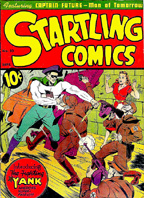 |
Startling Comics 10: America has a new hero. The origin of the Fighting Yank!
|
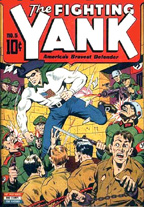 |
Fighting Yank #5: The Fighting Yank finds himself against a prehistoric German with a freezing touch.
|
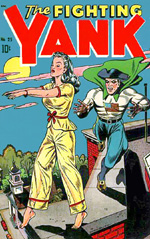 |
Fighting Yank #25: When a gangster falls in love and tries to go straight, the Fighting Yank must step in and lend Cupid a hand. A Mort Meskin and Jerry Robinson tale. |
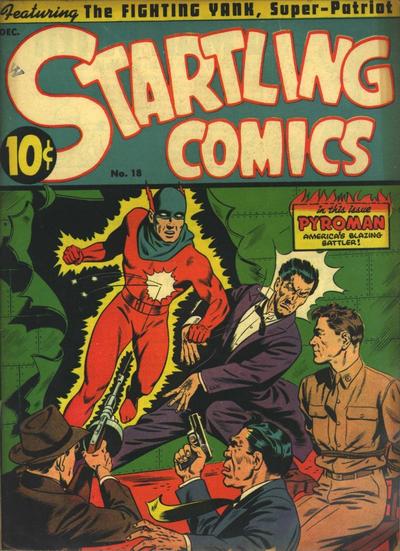 |
Startling 18, 1942: Fighting Yank vs Dr. Fantom and the Lycans (that's werewolves). Scans provided by Bill Nolan. |
